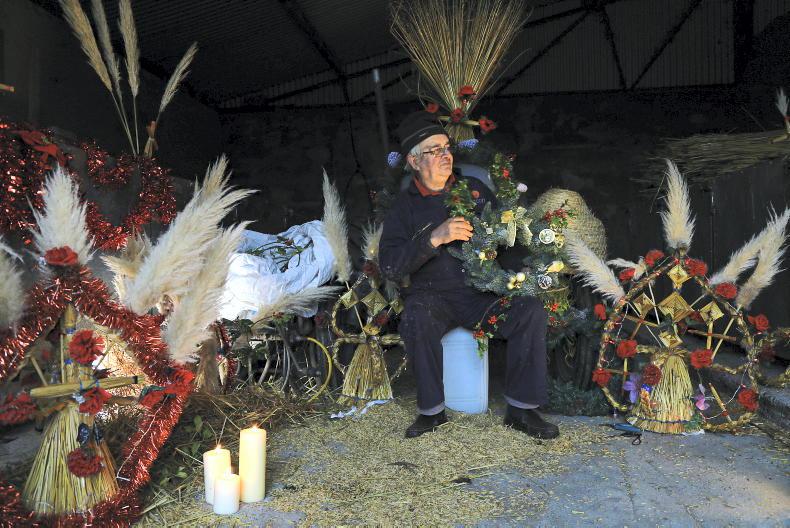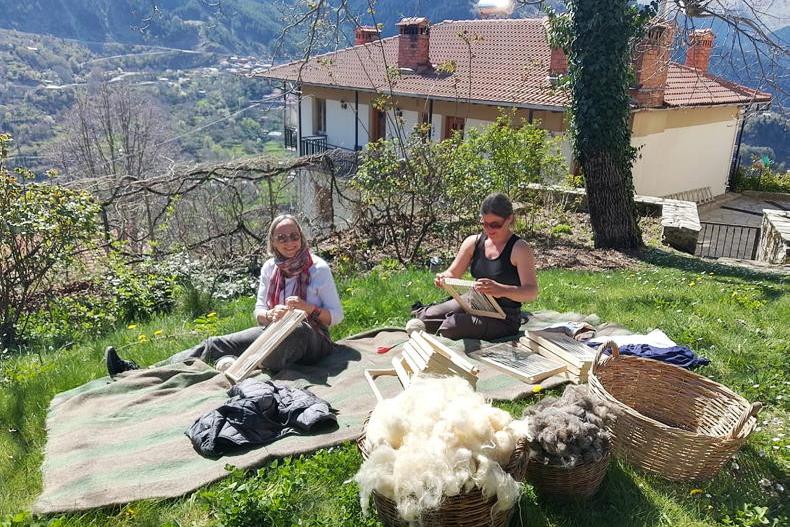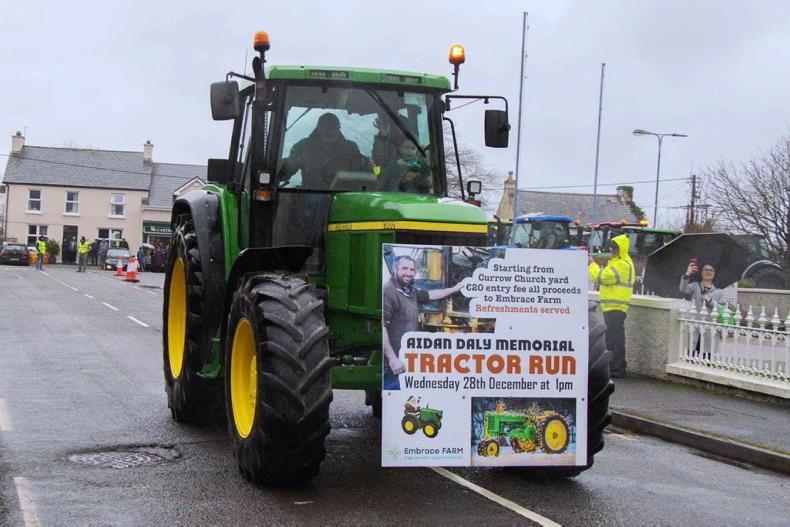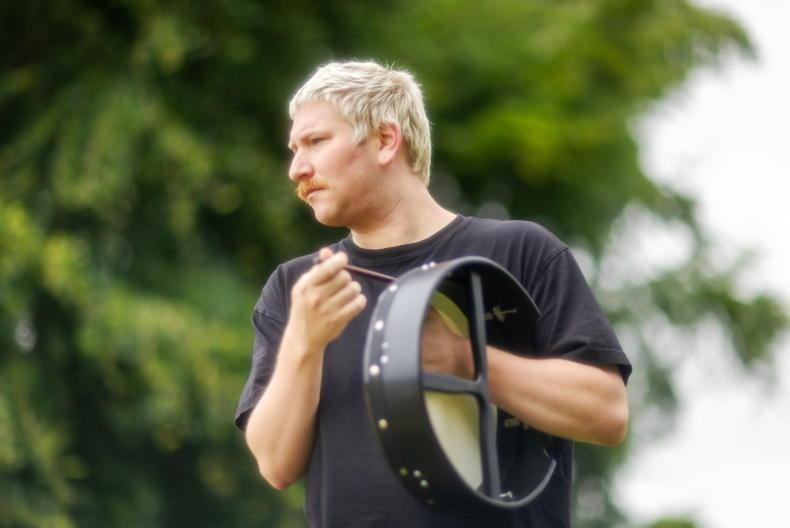I’m a sheep farmer from mid-Kerry, a little village called Kilgobnet, Beaufort.
We’re known all over the world, I’d say, for our Biddie.
The Biddie takes place around St Brigid’s Day. We only dress up in white clothes and a straw hat.
We travel around from house to house, going into towns and collecting a few pounds.
We give our money to a good cause then.
There’s a good bit of craic in it, there’d be dancing and singing. Anything with a crowd is enjoyable.
We carry the Brídóg. It’s like a doll and it’s a symbol of St Brigid. There’s a lot of history behind the Brídóg as well, that there was luck following her.
I’m with the Kilgobnet Biddie. There’s a junior Biddie for the national-school kids and a senior Biddie for the adults.
I’ll miss it this year, you’d miss the craic. I’d say there’d be about 50 of us
The senior Biddie is in aid of the school and the junior Biddie is for charity.
All our life we’re in the Biddies. There was video recorded in Killorglin in 1963 or ’64, I think there were about 20 groups in the Hall in Killorglin that time. There’d have been all different townlands.
I’ll miss it this year, you’d miss the craic. I’d say there’d be about 50 of us. We do it the last day of January and the first day of February.

The O’Connor Family of musicians, part of the Kilgobnet Biddies. From left: Marie, Sean, Brendan, Anthony and
Patrick. \ Valerie O’Sullivan
We’ve a lot of musicians. We’ve seven or eight accordion players, maybe a couple of banjos, a couple of fiddles, tin whistles and drums. We never had as much music in our lives. I play a little bit – the auld accordion– enough to frighten the crows.
We’ve a lot of new people now moving into our area here and they’re delighted with it
People, they’d be very upset if you didn’t go in to them. Guaranteed you’d get a bit of a telling off if you didn’t call.
We’ve a lot of new people now moving into our area here and they’re delighted with it. They follow us around and they have the craic. What we have is a couple of vans carrying us around. Of course there are a few bottles of beer and the hot stuff’d be there too.
Hats off
When I was younger I bought a straw hat for 10 Woodbines. I don’t know how much the Woodbines were that time, but they weren’t too dear anyway. I had my little hat then.
Ara, it’s going back so long that I kind of forget how I started making the hats myself.
There were very few making them. It just broke out in me, that was it.
I get the straw from a neighbour. There are very few growing the oaten straw now, it has to be oaten straw. Barley straw is too brittle and it would be too short as well. With the oaten straw you have a golden colour to it.
If I saw a group out around the country, say they were dressed with white pants, white shirt and everything, but they had no straw hat, well, I wouldn’t class them as a Biddie then
There’d be a good bit of cleaning off in the straw, you have to take off the grain first. Every little straw, you have to clean it one by one. So that’d be quite a few nights. Ah, you’d only go at it for an hour and then go doing something else because you’d get sick of it.
If I saw a group out around the country, say they were dressed with white pants, white shirt and everything, but they had no straw hat, well, I wouldn’t class them as a Biddie then. Lots of the people around here they wouldn’t class them that way either. Even the youngsters now, we like to see them with some little make of a straw hat.
I think the tradition will keep going, because the youngsters are very interested in it. I went to our own local school there a couple of times showing them how to make a hat and a St Brigid’s cross, and it’d surprise you the questions they’d hop off you.
They’ll last if you care for them and in fairness now the group we have they really looks after them
I was talking to the teacher the last time I was in there and I said: “Ye had them well taught to ask the questions”.
“There you’re wrong,” she said, “we hadn’t.” The questions came from themselves.
One of the lads will keep making the hats after me anyway. That tradition will stay for a bit. I’ll nearly have enough made that it’ll hold them going for a long time after me.
There’s about 50 or 60 hats there. They’ll last if you care for them and in fairness now the group we have they really looks after them.
I suppose they appreciate the amount of work that goes into them. A lot of them take pride in the hats.
The simplest way of describing the Biddie is that it’s similar to the Wren on St Stephen’s Day, but taking place 1 February – St Brigid’s Day.
It’s a blend of pagan and Christian customs. The Biddie is thought to have roots in Imbolg (a Gaelic traditional festival celebrating the start of spring) and also St Brigid’s Day.
Particularly in mid-Kerry, people up held the tradition of the Biddie, dressing up and travelling from house to house playing music, singing, dancing and entertaining. The area around Kilgobnet and Beaufort is a Biddie stronghold.
Read more
The Biddy: A rural revival
My Country Living: ‘It’s pride in who you are and what you have on the ground’
I’m a sheep farmer from mid-Kerry, a little village called Kilgobnet, Beaufort.
We’re known all over the world, I’d say, for our Biddie.
The Biddie takes place around St Brigid’s Day. We only dress up in white clothes and a straw hat.
We travel around from house to house, going into towns and collecting a few pounds.
We give our money to a good cause then.
There’s a good bit of craic in it, there’d be dancing and singing. Anything with a crowd is enjoyable.
We carry the Brídóg. It’s like a doll and it’s a symbol of St Brigid. There’s a lot of history behind the Brídóg as well, that there was luck following her.
I’m with the Kilgobnet Biddie. There’s a junior Biddie for the national-school kids and a senior Biddie for the adults.
I’ll miss it this year, you’d miss the craic. I’d say there’d be about 50 of us
The senior Biddie is in aid of the school and the junior Biddie is for charity.
All our life we’re in the Biddies. There was video recorded in Killorglin in 1963 or ’64, I think there were about 20 groups in the Hall in Killorglin that time. There’d have been all different townlands.
I’ll miss it this year, you’d miss the craic. I’d say there’d be about 50 of us. We do it the last day of January and the first day of February.

The O’Connor Family of musicians, part of the Kilgobnet Biddies. From left: Marie, Sean, Brendan, Anthony and
Patrick. \ Valerie O’Sullivan
We’ve a lot of musicians. We’ve seven or eight accordion players, maybe a couple of banjos, a couple of fiddles, tin whistles and drums. We never had as much music in our lives. I play a little bit – the auld accordion– enough to frighten the crows.
We’ve a lot of new people now moving into our area here and they’re delighted with it
People, they’d be very upset if you didn’t go in to them. Guaranteed you’d get a bit of a telling off if you didn’t call.
We’ve a lot of new people now moving into our area here and they’re delighted with it. They follow us around and they have the craic. What we have is a couple of vans carrying us around. Of course there are a few bottles of beer and the hot stuff’d be there too.
Hats off
When I was younger I bought a straw hat for 10 Woodbines. I don’t know how much the Woodbines were that time, but they weren’t too dear anyway. I had my little hat then.
Ara, it’s going back so long that I kind of forget how I started making the hats myself.
There were very few making them. It just broke out in me, that was it.
I get the straw from a neighbour. There are very few growing the oaten straw now, it has to be oaten straw. Barley straw is too brittle and it would be too short as well. With the oaten straw you have a golden colour to it.
If I saw a group out around the country, say they were dressed with white pants, white shirt and everything, but they had no straw hat, well, I wouldn’t class them as a Biddie then
There’d be a good bit of cleaning off in the straw, you have to take off the grain first. Every little straw, you have to clean it one by one. So that’d be quite a few nights. Ah, you’d only go at it for an hour and then go doing something else because you’d get sick of it.
If I saw a group out around the country, say they were dressed with white pants, white shirt and everything, but they had no straw hat, well, I wouldn’t class them as a Biddie then. Lots of the people around here they wouldn’t class them that way either. Even the youngsters now, we like to see them with some little make of a straw hat.
I think the tradition will keep going, because the youngsters are very interested in it. I went to our own local school there a couple of times showing them how to make a hat and a St Brigid’s cross, and it’d surprise you the questions they’d hop off you.
They’ll last if you care for them and in fairness now the group we have they really looks after them
I was talking to the teacher the last time I was in there and I said: “Ye had them well taught to ask the questions”.
“There you’re wrong,” she said, “we hadn’t.” The questions came from themselves.
One of the lads will keep making the hats after me anyway. That tradition will stay for a bit. I’ll nearly have enough made that it’ll hold them going for a long time after me.
There’s about 50 or 60 hats there. They’ll last if you care for them and in fairness now the group we have they really looks after them.
I suppose they appreciate the amount of work that goes into them. A lot of them take pride in the hats.
The simplest way of describing the Biddie is that it’s similar to the Wren on St Stephen’s Day, but taking place 1 February – St Brigid’s Day.
It’s a blend of pagan and Christian customs. The Biddie is thought to have roots in Imbolg (a Gaelic traditional festival celebrating the start of spring) and also St Brigid’s Day.
Particularly in mid-Kerry, people up held the tradition of the Biddie, dressing up and travelling from house to house playing music, singing, dancing and entertaining. The area around Kilgobnet and Beaufort is a Biddie stronghold.
Read more
The Biddy: A rural revival
My Country Living: ‘It’s pride in who you are and what you have on the ground’











SHARING OPTIONS